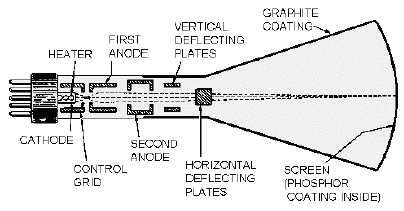6-2
inside the glass CRT. The electron gun generates electrons and focuses them into a narrow beam. The
deflection system moves the beam horizontally and vertically across the screen. The screen is coated with
a phosphorous material that glows when struck by the electrons. Figure 6-1 shows the construction of a
CRT.
Figure 6-1.—Construction of a CRT.
ELECTRON GUN
The ELECTRON GUN consists of a HEATER and a CATHODE to generate electrons, a
CONTROL GRID to control brightness by controlling electron flow, and two ANODES (FIRST and
SECOND). The main purpose of the first (FOCUSING) anode is to focus the electrons into a narrow
beam on the screen. The second (ACCELERATING) anode accelerates the electrons as they pass. The
control grid is cylindrical and has a small opening in a baffle at one end. The anodes consist of two
cylinders that contain baffles (or plates) with small holes in their centers.
Q-1. What element controls the number of electrons striking the screen?
Q-2. What element is controlled to focus the beam?
Cathode and Control Grid
As in most conventional electron tubes, the cathode is indirectly heated and emits a cloud of
electrons. The control grid is a hollow metal tube placed over the cathode. A small opening is located in
the center of a baffle at the end opposite the cathode. The control grid is maintained at a negative potential
with respect to the cathode to keep the electrons bunched together.
A high positive potential on the anodes pulls electrons through the hole in the grid. Because the grid
is near the cathode, it can control the number of electrons that are emitted. As in an ordinary electron
tube, the negative voltage of the grid can be varied either to control electron flow or stop it completely.
The brightness (intensity) of the image on the fluorescent screen is determined by the number of electrons
striking the screen. This is controlled by the voltage on the control grid.
Electrostatic Lenses and Focusing
The electron beam is focused by two ELECTROSTATIC FIELDS that exist between the control grid
and first anode and between the first and second anodes.
Figure 6-2 shows you how electrons move through the electron gun. The electrostatic field areas are
often referred to as LENSES because the fields bend electron streams in the same manner that optical



